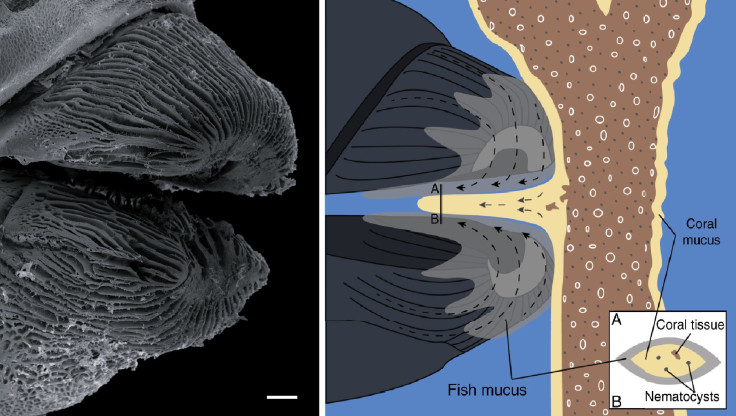Watch This Fish Suck A Coral Reef With Its Creepy Mucus Lips

Everyone knows what it’s like to get a slobbery kiss planted on a cheek, and it seems like that is something we have in common with the coral reefs. Scientists have taken a close-up of fish lips to find out just how certain species can safely eat off razor-sharp corals, and it turns out the fish are kissing the corals with lips covered in mucus.
Eating off a coral is no easy task: The animal has a sharp skeleton and venomous, stinging tentacles. But at least one fish, the tubelip wrasse, uses a sort of kissing motion to suck food right off it. With the help of mucus to assist in the kiss, its lips are protected from the stingers. The tubelip wrasse is found in the waters of the Indian Ocean and the western portion of the Pacific Ocean. A study in the journal Current Biology says it’s one of just 128 fish species that feed on corals — out of the roughly 6,000 that call the area around coral reefs their home.
Read: These Fish Can Teach Us About Human Evolution If We Stop Eating Them
“Of all coral feeders, tubelip wrasses appear to have modified their mouths the most to meet this dietary challenge,” the study says. “Their teeth and jaw bones resemble those of other wrasses, but their ability to feed on corals appears to derive primarily from the structure of their lips.”
The researchers used an electron microscope to take a closer look at those lips. They are “fleshy, protruding and form a tube when the mouth is closed, covering all of the teeth.” The fleshy lips are covered in membranes that “increase the lip surface area” and look like mushroom gills, the study says. Unlike mushrooms, however, they are covered in mucus. The researchers wrote the mucus is key because it protects the fish as well as creates “a seal for suction … on the uneven coral surface.”

“It is like having a running nose but having running lips instead,” David Bellwood of James Cook University in Australia said in a statement from journal publisher Cell Press. “One always assumes that fishes feed using their teeth, but, like us, the lips can be an essential tool. Imagine feeding without lips or cheeks; the same applies to fishes.”
To add to the odd layers, the mucus is protecting the fish so it can eat more mucus. The researchers said their observations suggest the food the fish remove from the coral is exterior mucus, another one of its protective tools along with the stinging tentacles.
Read: Hideous Fish Eats Things From the Inside Like an Alien
High-speed video shows how the fish do this: They quickly put their lips onto the coral and suck in. The study says the lips “did not grab or hold coral material. Rather, they appeared to be used for sealing the mouth over a small localized area, presumably to increase suction-feeding efficiency.”
An even tighter shot of the fish looks like it is going in for a kiss at the end of a first date before it quickly takes a peck off the coral.
© Copyright IBTimes 2024. All rights reserved.





















